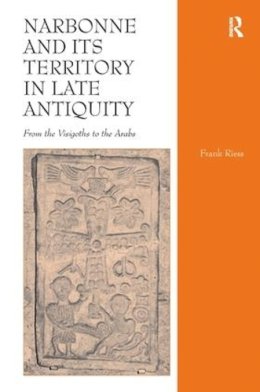
Stock image for illustration purposes only - book cover, edition or condition may vary.
Narbonne and Its Territory in Late Antiquity: From the Visigoths to the Arabs
Frank Riess
€ 176.33
FREE Delivery in Ireland
Description for Narbonne and Its Territory in Late Antiquity: From the Visigoths to the Arabs
Hardback. This work centres on the post-Roman period of Narbonne and its territory, up to its capture by the Arabs in 720, encompassing not only recent archaeological findings but also perspectives of French, Spanish and Catalan historiography that have fashioned distinct national narratives. Seeking to remove Narbonne from any subsequent birth of France. Num Pages: 304 pages, Includes 5 b&w illustrations and 5 maps. BIC Classification: 1DDF; 3D; 3F; HBLA. Category: (UP) Postgraduate, Research & Scholarly. Dimension: 237 x 173 x 24. Weight in Grams: 692.
This work centres on the post-Roman period of Narbonne and its territory, up to its capture by the Arabs in 720, encompassing not only recent archaeological findings but also perspectives of French, Spanish and Catalan historiography that have fashioned distinct national narratives. Seeking to remove Narbonne from any subsequent birth of France, Catalonia and Spain, the book presents a geopolitical region that took shape from the late fifth century, evolving towards the end of the eighth century into an autonomous province of the nascent Carolingian Empire. Capturing this change throughout a 300-year period somewhat lacking in written sources, the book takes us beyond an exclusive depiction of the classical city to an examination of settlement in various forms. Discourses of literary criticism also lie behind aspects of this study, mapped around textual commentaries which highlight a more imaginative biography of a city. Narbonne's role as a point of departure and travel across the Mediterranean is examined through a reading of the correspondence of Paulinus of Nola and the writings of Sulpicius Severus, enabling the reader to gain a fuller picture of the city and its port. The topography of Narbonne in the fifth century is surveyed together with Bishop Rusticus’s church-building programme. Later chapters emphasise the difficulties in presenting a detached image of Narbonne, as sources become mainly Visigothic, defining the city and its region as part of a centralised kingdom. Particular attention is given to the election of Liuva I as king in Narbonne in 568, and to the later division into upper and lower sub-kingdoms shared by Liuva and his brother Leovigild, a duality that persisted throughout the sixth and seventh centuries. The study therefore casts new light on Narbonne and its place within the Visigothic Kingdom of Toledo, suggesting that it was the capital of a territory with roots in the post-Roman settlement of barbarian successor states.
Product Details
Format
Hardback
Publication date
2013
Publisher
Taylor & Francis Ltd
Condition
New
Number of Pages
304
Place of Publication
London, United Kingdom
ISBN
9781409455349
SKU
V9781409455349
Shipping Time
Usually ships in 15 to 20 working days
Ref
99-20
About Frank Riess
Frank Riess is an Honorary Research Fellow at Birkbeck College, London, UK.
Reviews for Narbonne and Its Territory in Late Antiquity: From the Visigoths to the Arabs
'...Riess monograph exhibits the virtues of a regionalist approach while, at the same time, persuasively arguing for Narbonnes relevance to the greater political, military, and diplomatic affairs of the post-Roman Mediterranean world.' Bryn Mawr Classical Review 'Riess excites with the interplay of textual and material evidence. Valuable and informative set pieces result; examples include an investigation of the location of Sulpicius Severus’s retreat, Primuliacum (pp. 66-69); analysis of Narbonne’s Christian origins (pp. 115-17); and examination of Narbonne’s hinterland in light of recent archeological categorizations for rural settlements (pp. 194-203). In sum Riess’s book exemplifies the outstanding scholarship one can achieve by mastering the intertwining of textual and archaeological evidence.’ Journal of Late Antiquity '... thoroughly impressive ... Riess persuasively argues that the region of Narbonne was integral to events ranging across Hispania and was in turn shaped by events in an even wider political theatre that involved Visigothic, Frankish, Burgundian, Ostrogothic, Byzantine and Arab interests.' H-France Review
